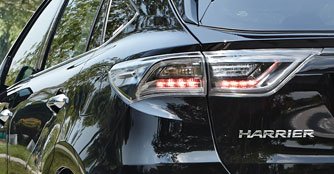Toyota Harrier 2.0 Premium (A) Review
06 Jun 2014|257,411 views
Back in the late 1990s when Toyota introduced its original Harrier, the Japan domestic market (JDM) equivalent and basis of the first generation Lexus RX, the marketers ran the tagline 'Wild But Formal'.
Supporting this peculiar catchphrase was an equally peculiar television commercial that features a lion man in a suit, supposedly of the strong and silent type. The ad is bizarre, but strangely entertaining if you're into weird Japanese ads.
Offbeat advertising aside, the Harrier did well because it was a significantly cheaper (by $25k - $50k depending on the dealer/deal) alternative to the Lexus RX300, the Harrier's higher class twin at Borneo Motors.
The current Lexus RX (the legit one), on sale since 2009 as a third generation model, hasn't been harassed by the Harrier in the local marketplace, because the Lexus' JDM alter ego had to soldier on as a second generation model and looked increasingly dated as the years rolled on.
Only in December last year, a decade after the debut of the previous Harrier, did Toyota release a successor.
Supporting this peculiar catchphrase was an equally peculiar television commercial that features a lion man in a suit, supposedly of the strong and silent type. The ad is bizarre, but strangely entertaining if you're into weird Japanese ads.
Offbeat advertising aside, the Harrier did well because it was a significantly cheaper (by $25k - $50k depending on the dealer/deal) alternative to the Lexus RX300, the Harrier's higher class twin at Borneo Motors.
The current Lexus RX (the legit one), on sale since 2009 as a third generation model, hasn't been harassed by the Harrier in the local marketplace, because the Lexus' JDM alter ego had to soldier on as a second generation model and looked increasingly dated as the years rolled on.
Only in December last year, a decade after the debut of the previous Harrier, did Toyota release a successor.
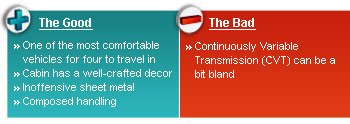 |
Exterior
The new Harrier isn't based on the current Lexus RX. Instead, it employs the 2,660mm long platform of the RAV4/Vanguard, with the same 190mm ground clearance. The Harrier looks sharper than its two crossover cousins, with Toyota describing the exterior design as 'elegant velocity', which is about as meaningful as 'wild but formal'.
It's certainly a handsome machine, especially in business-like black, or better still, colour code 220 - Sparkling Black Pearl Crystal Shine. Said paint job is indeed shiny, and it sparkles.
Even though the chrome appliques above the unusual grille and along the lower portion of the doors look heavy-handed compared to how Lexus designers would apply chrome trim on a crossover, they're neither excessive nor offensive.
Inoffensive, too, are the two exterior elements on the Harrier that you won't find on today's Lexus RX - a wiper parked at the base of the rear windscreen (the Lexus' rear wiper is concealed under the top edge of the tailgate) and visible exhaust piping underneath the rear bumper (the Lexus' is tucked away).
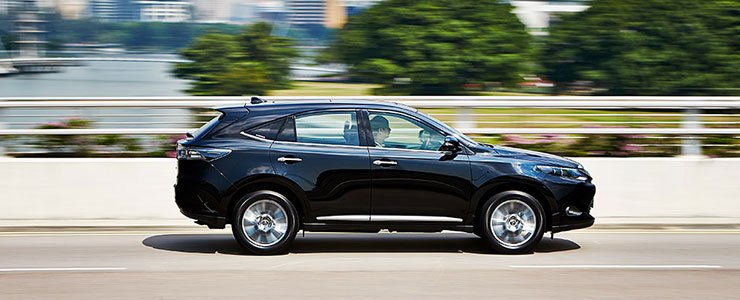 |
Interior
Inside the cabin, Harrier the hawk (logo) is on the hunt for your attention - open a front door and the name is illuminated on the doorsill; close the same door and you'll spot the hawk perched on the door panel trim.
The instrumentation, switchgear and (locally fitted) Alpine head unit are idiot-proof, but the Japanese text used for the multi-info in-dash display is a mystery for drivers whose command of the language is limited to keywords such as 'sushi', 'ramen', 'Sony' and 'Mitsubishi'.
Thankfully, the same display also uses universal automotive symbols and basic English (mainly 'ON' and 'OFF'), so the Harrier driver won't be experiencing a hairy drive caused by his inability to understand what the car is trying to inform him.
The amount of information displayed depends on the Harrier's 'grade' (Japanese automakers' term for 'variant') - Grand is the basic spec, Elegance is the mid-range spec, and Premium is the highest spec. There's also a Premium Advanced Package with the bells and whistles.
Inside the cabin, Harrier the hawk (logo) is on the hunt for your attention - open a front door and the name is illuminated on the doorsill; close the same door and you'll spot the hawk perched on the door panel trim.
The instrumentation, switchgear and (locally fitted) Alpine head unit are idiot-proof, but the Japanese text used for the multi-info in-dash display is a mystery for drivers whose command of the language is limited to keywords such as 'sushi', 'ramen', 'Sony' and 'Mitsubishi'.
Thankfully, the same display also uses universal automotive symbols and basic English (mainly 'ON' and 'OFF'), so the Harrier driver won't be experiencing a hairy drive caused by his inability to understand what the car is trying to inform him.
The amount of information displayed depends on the Harrier's 'grade' (Japanese automakers' term for 'variant') - Grand is the basic spec, Elegance is the mid-range spec, and Premium is the highest spec. There's also a Premium Advanced Package with the bells and whistles.
Two engine options are available for the Harrier - a 2.0-litre four-cylinder and a 2.5-litre hybrid four-cylinder, both with a CVT and either front-wheel drive or part-time four-wheel drive.
Tested here (and lent to us by Richburg Motors) is the 2.0-litre, front-drive Harrier in Premium spec. The equipment is suitably premium, and includes electrical adjustment of the driver's seat and steering wheel, computerised climate control with fingertip 'touch' operation, convenient cruise control, a powered tilt-and-slide moonroof, a powered tailgate, and express up/down for every power window.

 Unless you can read Japanese, the text displayed on the multi-info in-dash can be a small problem for local drivers
Unless you can read Japanese, the text displayed on the multi-info in-dash can be a small problem for local drivers
Each window also stops closing automatically if it detects a hand or arm in the way - Toyota claims this is world-first technology, but maybe it's referring to how the window detects an obstacle in its path.
Tested here (and lent to us by Richburg Motors) is the 2.0-litre, front-drive Harrier in Premium spec. The equipment is suitably premium, and includes electrical adjustment of the driver's seat and steering wheel, computerised climate control with fingertip 'touch' operation, convenient cruise control, a powered tilt-and-slide moonroof, a powered tailgate, and express up/down for every power window.

Each window also stops closing automatically if it detects a hand or arm in the way - Toyota claims this is world-first technology, but maybe it's referring to how the window detects an obstacle in its path.
 |
Another safety feature is Lane Departure Alert (LDA), which notifies the driver (with a buzzer and a warning light) if the Harrier deviates from its road lane. The system even applies a gentle counter-force to the steering wheel to 'wake' the inattentive driver.
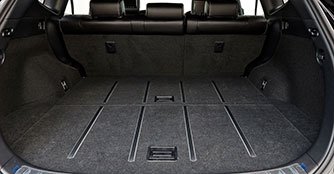
 440 litres of squarish boot space will facilitate the placement of items, some of which can be stowed below the deck
440 litres of squarish boot space will facilitate the placement of items, some of which can be stowed below the deck
I wouldn't blame him, though, because the Harrier cabin is so relaxing. Behind the wheel, the outward visibility is good in every direction, helped by the reverse-parking camera and the kerbside 'under-mirror'.

I wouldn't blame him, though, because the Harrier cabin is so relaxing. Behind the wheel, the outward visibility is good in every direction, helped by the reverse-parking camera and the kerbside 'under-mirror'.
The seats, upholstered in a JDM mix of leather and fabric, are plush and seemingly durable enough for the usual suburban-crossover rigours, and they come with well-padded armrests. Even the stitching (double across the dash-top and upper door panels, single elsewhere) is nice, like the realistic 'wood' ornamentation and the blueish ambient lighting.
The interior space is excellent - the backseat offers generous legroom, an adjustable 'lounging' angle and an almost flat floorboard.
The rear air-con vents are small, but their output is big enough to keep rear passengers cooler in hot weather. There are also plenty of storage pockets for personal belongings and bric-a-brac.
The interior space is excellent - the backseat offers generous legroom, an adjustable 'lounging' angle and an almost flat floorboard.
The rear air-con vents are small, but their output is big enough to keep rear passengers cooler in hot weather. There are also plenty of storage pockets for personal belongings and bric-a-brac.
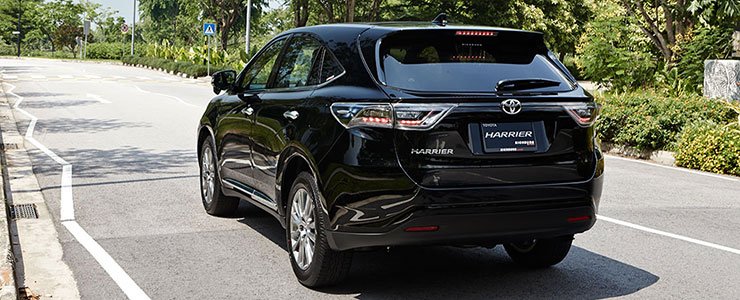 |
The Drive
On the move, it's obvious that the Harrier has a hardworking four-cylinder engine. It's vocal when stretched, but that's no surprise. What's surprising is the remotely sporty tone when the engine revs go above 4,000rpm.
The car's Continuously Variable Transmission (CVT) is tofu-smooth in its operation, but a bit bland (like said protein food) if you're used to sensing the gear changes of a traditional automatic gearbox.
On the move, it's obvious that the Harrier has a hardworking four-cylinder engine. It's vocal when stretched, but that's no surprise. What's surprising is the remotely sporty tone when the engine revs go above 4,000rpm.
The car's Continuously Variable Transmission (CVT) is tofu-smooth in its operation, but a bit bland (like said protein food) if you're used to sensing the gear changes of a traditional automatic gearbox.
The CVT has a 'PWR' mode that sacrifices some refinement and fuel efficiency for livelier pick up, which is useful if the Harrier man is in a hurry. If he isn't hurrying anywhere and just wants to 'zen' out, there's an 'ECO' mode that makes the CVT smoother (and slower to respond) than the smoothest tofu.
The Harrier rides quietly on roads that are as perfectly paved as Japan's. It's less quiet over rough tarmac patches, but the suspension (with struts in the front and a double-wishbone arrangement in the rear) is always absorbent and never jumpy.
The car's handling is composed, too, with predictable steering reactions, steady body movements, and reliable grip from the 235/55 R18 Bridgestone Dueler tyres.
Conclusion
In summary, the Harrier man can, and so can you.
The Harrier rides quietly on roads that are as perfectly paved as Japan's. It's less quiet over rough tarmac patches, but the suspension (with struts in the front and a double-wishbone arrangement in the rear) is always absorbent and never jumpy.
The car's handling is composed, too, with predictable steering reactions, steady body movements, and reliable grip from the 235/55 R18 Bridgestone Dueler tyres.
Conclusion
In summary, the Harrier man can, and so can you.
Back in the late 1990s when Toyota introduced its original Harrier, the Japan domestic market (JDM) equivalent and basis of the first generation Lexus RX, the marketers ran the tagline 'Wild But Formal'.
Supporting this peculiar catchphrase was an equally peculiar television commercial that features a lion man in a suit, supposedly of the strong and silent type. The ad is bizarre, but strangely entertaining if you're into weird Japanese ads.
Offbeat advertising aside, the Harrier did well because it was a significantly cheaper (by $25k - $50k depending on the dealer/deal) alternative to the Lexus RX300, the Harrier's higher class twin at Borneo Motors.
The current Lexus RX (the legit one), on sale since 2009 as a third generation model, hasn't been harassed by the Harrier in the local marketplace, because the Lexus' JDM alter ego had to soldier on as a second generation model and looked increasingly dated as the years rolled on.
Only in December last year, a decade after the debut of the previous Harrier, did Toyota release a successor.
Supporting this peculiar catchphrase was an equally peculiar television commercial that features a lion man in a suit, supposedly of the strong and silent type. The ad is bizarre, but strangely entertaining if you're into weird Japanese ads.
Offbeat advertising aside, the Harrier did well because it was a significantly cheaper (by $25k - $50k depending on the dealer/deal) alternative to the Lexus RX300, the Harrier's higher class twin at Borneo Motors.
The current Lexus RX (the legit one), on sale since 2009 as a third generation model, hasn't been harassed by the Harrier in the local marketplace, because the Lexus' JDM alter ego had to soldier on as a second generation model and looked increasingly dated as the years rolled on.
Only in December last year, a decade after the debut of the previous Harrier, did Toyota release a successor.
Exterior
The new Harrier isn't based on the current Lexus RX. Instead, it employs the 2,660mm long platform of the RAV4/Vanguard, with the same 190mm ground clearance. The Harrier looks sharper than its two crossover cousins, with Toyota describing the exterior design as 'elegant velocity', which is about as meaningful as 'wild but formal'.
It's certainly a handsome machine, especially in business-like black, or better still, colour code 220 - Sparkling Black Pearl Crystal Shine. Said paint job is indeed shiny, and it sparkles.
Even though the chrome appliques above the unusual grille and along the lower portion of the doors look heavy-handed compared to how Lexus designers would apply chrome trim on a crossover, they're neither excessive nor offensive.
Inoffensive, too, are the two exterior elements on the Harrier that you won't find on today's Lexus RX - a wiper parked at the base of the rear windscreen (the Lexus' rear wiper is concealed under the top edge of the tailgate) and visible exhaust piping underneath the rear bumper (the Lexus' is tucked away).
Interior
Inside the cabin, Harrier the hawk (logo) is on the hunt for your attention - open a front door and the name is illuminated on the doorsill; close the same door and you'll spot the hawk perched on the door panel trim.
The instrumentation, switchgear and (locally fitted) Alpine head unit are idiot-proof, but the Japanese text used for the multi-info in-dash display is a mystery for drivers whose command of the language is limited to keywords such as 'sushi', 'ramen', 'Sony' and 'Mitsubishi'.
Thankfully, the same display also uses universal automotive symbols and basic English (mainly 'ON' and 'OFF'), so the Harrier driver won't be experiencing a hairy drive caused by his inability to understand what the car is trying to inform him.
The amount of information displayed depends on the Harrier's 'grade' (Japanese automakers' term for 'variant') - Grand is the basic spec, Elegance is the mid-range spec, and Premium is the highest spec. There's also a Premium Advanced Package with the bells and whistles.
Inside the cabin, Harrier the hawk (logo) is on the hunt for your attention - open a front door and the name is illuminated on the doorsill; close the same door and you'll spot the hawk perched on the door panel trim.
The instrumentation, switchgear and (locally fitted) Alpine head unit are idiot-proof, but the Japanese text used for the multi-info in-dash display is a mystery for drivers whose command of the language is limited to keywords such as 'sushi', 'ramen', 'Sony' and 'Mitsubishi'.
Thankfully, the same display also uses universal automotive symbols and basic English (mainly 'ON' and 'OFF'), so the Harrier driver won't be experiencing a hairy drive caused by his inability to understand what the car is trying to inform him.
The amount of information displayed depends on the Harrier's 'grade' (Japanese automakers' term for 'variant') - Grand is the basic spec, Elegance is the mid-range spec, and Premium is the highest spec. There's also a Premium Advanced Package with the bells and whistles.
Two engine options are available for the Harrier - a 2.0-litre four-cylinder and a 2.5-litre hybrid four-cylinder, both with a CVT and either front-wheel drive or part-time four-wheel drive.
Tested here (and lent to us by Richburg Motors) is the 2.0-litre, front-drive Harrier in Premium spec. The equipment is suitably premium, and includes electrical adjustment of the driver's seat and steering wheel, computerised climate control with fingertip 'touch' operation, convenient cruise control, a powered tilt-and-slide moonroof, a powered tailgate, and express up/down for every power window.
Each window also stops closing automatically if it detects a hand or arm in the way - Toyota claims this is world-first technology, but maybe it's referring to how the window detects an obstacle in its path.
Tested here (and lent to us by Richburg Motors) is the 2.0-litre, front-drive Harrier in Premium spec. The equipment is suitably premium, and includes electrical adjustment of the driver's seat and steering wheel, computerised climate control with fingertip 'touch' operation, convenient cruise control, a powered tilt-and-slide moonroof, a powered tailgate, and express up/down for every power window.
Each window also stops closing automatically if it detects a hand or arm in the way - Toyota claims this is world-first technology, but maybe it's referring to how the window detects an obstacle in its path.
Another safety feature is Lane Departure Alert (LDA), which notifies the driver (with a buzzer and a warning light) if the Harrier deviates from its road lane. The system even applies a gentle counter-force to the steering wheel to 'wake' the inattentive driver.
I wouldn't blame him, though, because the Harrier cabin is so relaxing. Behind the wheel, the outward visibility is good in every direction, helped by the reverse-parking camera and the kerbside 'under-mirror'.
I wouldn't blame him, though, because the Harrier cabin is so relaxing. Behind the wheel, the outward visibility is good in every direction, helped by the reverse-parking camera and the kerbside 'under-mirror'.
The seats, upholstered in a JDM mix of leather and fabric, are plush and seemingly durable enough for the usual suburban-crossover rigours, and they come with well-padded armrests. Even the stitching (double across the dash-top and upper door panels, single elsewhere) is nice, like the realistic 'wood' ornamentation and the blueish ambient lighting.
The interior space is excellent - the backseat offers generous legroom, an adjustable 'lounging' angle and an almost flat floorboard.
The rear air-con vents are small, but their output is big enough to keep rear passengers cooler in hot weather. There are also plenty of storage pockets for personal belongings and bric-a-brac.
The interior space is excellent - the backseat offers generous legroom, an adjustable 'lounging' angle and an almost flat floorboard.
The rear air-con vents are small, but their output is big enough to keep rear passengers cooler in hot weather. There are also plenty of storage pockets for personal belongings and bric-a-brac.
The Drive
On the move, it's obvious that the Harrier has a hardworking four-cylinder engine. It's vocal when stretched, but that's no surprise. What's surprising is the remotely sporty tone when the engine revs go above 4,000rpm.
The car's Continuously Variable Transmission (CVT) is tofu-smooth in its operation, but a bit bland (like said protein food) if you're used to sensing the gear changes of a traditional automatic gearbox.
On the move, it's obvious that the Harrier has a hardworking four-cylinder engine. It's vocal when stretched, but that's no surprise. What's surprising is the remotely sporty tone when the engine revs go above 4,000rpm.
The car's Continuously Variable Transmission (CVT) is tofu-smooth in its operation, but a bit bland (like said protein food) if you're used to sensing the gear changes of a traditional automatic gearbox.
The CVT has a 'PWR' mode that sacrifices some refinement and fuel efficiency for livelier pick up, which is useful if the Harrier man is in a hurry. If he isn't hurrying anywhere and just wants to 'zen' out, there's an 'ECO' mode that makes the CVT smoother (and slower to respond) than the smoothest tofu.
The Harrier rides quietly on roads that are as perfectly paved as Japan's. It's less quiet over rough tarmac patches, but the suspension (with struts in the front and a double-wishbone arrangement in the rear) is always absorbent and never jumpy.
The car's handling is composed, too, with predictable steering reactions, steady body movements, and reliable grip from the 235/55 R18 Bridgestone Dueler tyres.
Conclusion
In summary, the Harrier man can, and so can you.
The Harrier rides quietly on roads that are as perfectly paved as Japan's. It's less quiet over rough tarmac patches, but the suspension (with struts in the front and a double-wishbone arrangement in the rear) is always absorbent and never jumpy.
The car's handling is composed, too, with predictable steering reactions, steady body movements, and reliable grip from the 235/55 R18 Bridgestone Dueler tyres.
Conclusion
In summary, the Harrier man can, and so can you.
Car Information
Toyota Harrier 2.0 Premium (A)
CAT B|Petrol|16km/L
Horsepower
111kW (149 bhp)
Torque
193 Nm
Acceleration
-
This model is no longer being sold by local distributor
All Used Toyota HarrierThank You For Your Subscription.















